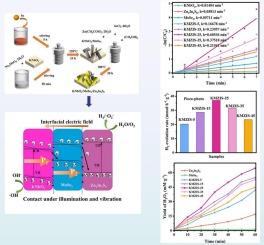Regulating carrier transport in dual Z-scheme heterojunction KNbO3/MoSe2/Zn2In2S5 by dual piezoelectric polarization electric field
IF 6.9
2区 材料科学
Q2 CHEMISTRY, PHYSICAL
引用次数: 0
Abstract
Reasonable design of heterojunction is a rational way to boost charge separation and piezo-photocatalytic performance of semiconductors. Herein, a dual Z-scheme KNbO3/MoSe2/Zn2In2S5 (KMZIS) heterojunction was synthesized, in which KNbO3 and MoSe2 provide piezoelectricity, and Zn2In2S5 offers photoactivity. UV–Vis DRS, Mott–Schottky plots, and DFT calculations confirmed the existence of two co-directional built-in electric fields, which respectively enhanced the accumulation of photogenerated electrons and holes on the conduction band of Zn2In2S5 and the valence band of KNbO3, respectively, enabling the heterojunction to exhibit stronger redox capabilities under illumination. Under mechanical vibration, the maximum piezoelectric current density of KMZIS-25 can reach up to 26.7 µA /cm2, which is 1.7 and 2.6 times higher than that of KNbO3/MoSe2 and MoSe2/Zn2In2S5, respectively. Under the synergistic piezoelectric–photoelectric coupling effect, KMZIS-25 exhibits a TCH degradation rate constant of 60.53 × 10-2 min−1, a H2O2 yield of 64.70 mmol·h−1·g−1, and a H2 evolution rate of 37.12 mmol·h−1·g−1, which are 4.6, 4.4, and 4.1 times higher than photocatalysis alone, and 3.8, 3.1, and 2.7 times higher than piezocatalysis alone. This indicates that the bi-piezoelectric field synergistically accelerates charge transfer in KMZIS, thereby significantly improving the catalytic performance of heterojunction.

双压电极化电场调节双z型异质结KNbO3/MoSe2/Zn2In2S5的载流子输运
合理设计异质结是提高半导体电荷分离和压电光催化性能的有效途径。本文合成了一种双Z-scheme KNbO3/MoSe2/Zn2In2S5 (KMZIS)异质结,其中KNbO3和MoSe2提供压电性,Zn2In2S5提供光活性。UV-Vis DRS、Mott-Schottky图和DFT计算证实了两个共向内嵌电场的存在,这两个电场分别增强了Zn2In2S5的导带和KNbO3的价带上光电子和空穴的积累,使异质结在光照下表现出更强的氧化还原能力。在机械振动下,KMZIS-25的最大压电电流密度可达26.7µA /cm2,分别是KNbO3/MoSe2和MoSe2/Zn2In2S5的1.7倍和2.6倍。在压电-光电协同耦合作用下,KMZIS-25的TCH降解速率常数为60.53 × 10-2 min−1,H2O2产率为64.70 mmol·h−1·g−1,H2析出速率为37.12 mmol·h−1·g−1,分别是光催化的4.6、4.4和4.1倍,是压电催化的3.8、3.1和2.7倍。这表明双压电场协同加速了KMZIS中的电荷转移,从而显著提高了异质结的催化性能。
本文章由计算机程序翻译,如有差异,请以英文原文为准。
求助全文
约1分钟内获得全文
求助全文
来源期刊

Applied Surface Science
工程技术-材料科学:膜
CiteScore
12.50
自引率
7.50%
发文量
3393
审稿时长
67 days
期刊介绍:
Applied Surface Science covers topics contributing to a better understanding of surfaces, interfaces, nanostructures and their applications. The journal is concerned with scientific research on the atomic and molecular level of material properties determined with specific surface analytical techniques and/or computational methods, as well as the processing of such structures.
 求助内容:
求助内容: 应助结果提醒方式:
应助结果提醒方式:


